Obtaining the set
TTDX switches
Definition of Services
Passenger services
Freight services
Engines
Steam
Diesel
Electric
Train sets
Coaches
Passenger and mail coaches
Freight wagons
Additional information
weight tables
| years | engine | coaches |
|---|---|---|
| 1956-1980 | ET-30 train set | |
| 1971- | BR 420 train set | |
| 1980- | BR 111 | S-Bahn coaches |
Regional services
Being the most basic commuter service in the game, regional trains take passengers over small distances. These can be runs on
branch lines as well as all-stop routes on main lines. Usually local coaches such as the famous "Silverfish" coaches will
be used for these services, but after 1997 also long-distance coaches are introduced for this type of service. Regional
trains typically consist of three to five passenger coaches and an additional mail car (in reality, this would be the baggage
van). Of course more or less cars can be used as required.
Until the mid 1990s, it was quite common to have coaches in different livery within single consists, i.e. trains made up of
silver, white/mint and traffic red coaches could be found. Beginning in the mid-1990s the older coaches should then be
replaced to get more uniform consists. The numbers in the coaches column just indicate how many passenger / mail coaches
the consist usually has in my games, choose one more or less as appropriate.
| non-electrified | electrified | years | engine | coaches | remarks | years | engine | coaches | remarks |
|---|---|---|---|---|---|---|---|
| 1920-1935 | BR 92 | 3 / 1 | short pre-war coaches | 1920-1935 | E62 | 3 / 1 | short pre-war coaches |
| 1922-1960 | BR 75 | 4 / 1 | DRG local coaches "Thunderbolt" type | 1924-1965 | E52 | 4 / 1 | DRG local coaches "Thunderbolt" type |
| 1922-1965 | BR 38 | 4 / 1 | DRG local coaches | 1927-1959 | ET-87 train set | ||
| 1952-1980s | VT-08 train set | 1956- | BR 140 | 4 / 1 | silverfish coaches mixed with older ones | ||
| 1952-1990s | VT-95 rail bus | 1956-1980 | ET-30 train set | ||||
| 1954-1980s | BR 515 rail bus | 1960-1980 | E16* | 4 / 1 | silverfish coaches mixed with older ones | ||
| 1962-1990s | V-100 | 4 / 1 | silverfish coaches mixed with older ones | 1971- | BR 420 train set | regional S-Bahn type of services | |
| 1972- | BR 614 train set | 1980- | BR 111 | 4 / 1 | regional S-Bahn type of services | ||
| 1987- | BR 218* | 4 / 2 | mixed coaches, replace older ones until 2000 | 1987- | BR 110* | 4 / 2 | mixed coaches, replace older ones until 2000 |
| 1998- | BR 612 train set | 1997- | BR 112 | 4 / 2 | mixed coaches, replace older ones until 2000 | ||
Medium services
These services are all trains fitting into the niche between regional services and premium services, resulting in mainline services for medium distances between bigger cities. These services can be introduced as soon as long-distance coaches are available. Usually, medium services use the standard livery of these coaches, but in the past a mixture of different liveries was also quite common. All the following kinds of services belong to the medium services:
| Name | time | description |
|---|---|---|
| Express | 1925 - 1974 | green long-distance coaches, sometimes also with a red dining car |
| D-Zug | 1974 - 1987 | long-distance trains in cream/blue livery |
| InterRegio | 1987 - 1997 | long-distance coaches in gray/blue |
Medium services were slowly discontinued after 1997 to be replaced by regional and premium trains, depending on the routes.
| non-electrified | electrified | years | engine | coaches | remarks | years | engine | coaches | remarks |
|---|---|---|---|---|---|---|---|
| 1925-1955 | BR 18 | 5 / 1 | DRG long-distance coaches | 1926-1960 | E16 | 5 / 1 | mixed long-distance coaches over time |
| 1930-1974 | BR 01 | 5 / 1 | mixed long-distance coaches over time | 1956-1959 | BR 110 | 5 / 1 | mixed long-distance coaches over time |
| 1936-1958 | BR 05 | 5 / 1 | DRG long-distance coaches | 1974- | BR 111 | 5 / 2 | D-Zug coaches, later Interregio coaches |
| 1974-1984 | V-200* | 5 / 2 | D-Zug coaches | 1974- | BR 181 | 5 / 2 | D-Zug coaches, later Interregio coaches |
| 1974-1990s | BR 218* | 5 / 2 | green coaches until 1974, then D-Zug coaches | 1987- | BR 120* | 5 / 2 | Interregio coaches |
Premium services
This is the best transport available, using the fastest engines and the best coaches, often painted in special liveries and given extra names. These trains only stop at major towns and travel long distances. Notice that the carriages for these special services get a slightly higher capacity. Depending on the length of the trains you will also get special dining and dome cars. For the InterCityExpress services, special high-speed tracks should be built to separate them from all other traffic. Otherwise they will never be able to even reach their top speed. Also note that this list only comprises the most important services, at least the VT-137 and ET-11 are missing, as they did premium services, but not in the categories listed below.
| Name | time | description |
|---|---|---|
| Rheingold | 1928 - 1939 | international express train in cream/lilac |
| "F" trains | 1950 - 1959 | national and international express trains |
| Rheingold II | 1960 - 1967 | international express train with dining car and dome car |
| TEE | 1968 - 1986 | Trans-Europe-Express in cream/red, featuring a dining car (and a dome car) |
| InterCity | 1987 - | national express train in gray/red, after 1997 in ICE colors |
| InterCityExpress | 1990 - | special high speed national express trains in white with a red stripe |
| non-electrified | electrified | years | engine | coaches | remarks | years | engine | coaches | remarks |
|---|---|---|---|---|---|---|---|
| 1928-1939 | BR 18 | 6 / 1 | Rheingold | 1956-1987 | BR 110 | 6 / 1 | "F"-trains, Rheingold II, TEE |
| 1930-1960 | BR 01 | 6 / 1 | Rheingold, "F"-trains | 1968-1987 | BR 103 | 6 / 1 | TEE |
| 1954-1974 | V200 | 6 / 1 | "F"-Trains, TEE | 1979- | BR 120 | 6 / 2 | TEE, Intercity |
| 1957-1974 | VT-11 | 6 / 1 | TEE | 1990- | BR 112 | 6 / 2 | Intercity |
| 1968-1974 | BR 218 | 6 / 1 | TEE | 1990- | ICE-1 | 7 / 2 | |
| 1998-(2003) | ICE-TD train set | due for early retirement... | 1996- | BR 101 | 6 / 2 | Intercity | |
| 1998- | ICE-3 train set | ||||||
Freight services
Even though all the different passenger trains are quite interesting, most money in TTDX is made by transporting freight, especially in early games when towns are still quite small and do not generate a lot of passengers. DBSetXL offers a broad range of cars for the different types of freight, and a number of additional carriages that all transport "goods", but show them as many different products, i.e. as cars or chemicals. For the sake of simplicity the different types of freight can be divided in broader categories as below. The suitable locos listed are only rough guidelines, you may choose any other freight loco, depending on the actual service.
Bulk materials
Bulk materials in TTDX are coal, grain and iron ore. They are usually transported in large amounts, using very long and heavy
trains. The speed of transportation does not matter very much with these materials. The most important factor for choosing
engines for such trains is their power and tractive effort.
Suitable locos: any of the real powerful types such as BR 45, BR 232, or electrics like the E94 and its successors
Livestock
Livestock have their own category, because they are quite unique. They are not suitable to be transported on very
fast trains, as they will get moved around a lot in their wagons by inertia. On the other hand, livestock is not too heavy,
so even an engine that is too weak for other freight services can be used.
Suitable locos: any available, but not the newest powerful electrics because of the fast acceleration
Liquid cargo
This is split into two groups, Oil and Chemicals. These can be transported faster than bulk materials, but are usually
transported in larger amounts, so are similar in this regard. As oil is usually transported with tank wagons in the
temperate climate, the main type of train used here would be feeder trains, taking the oil from the coast to the refinery.
Chemicals would then be taken from the Refinery to the town/city.
Suitable locos: depending on the length of the train, usually any loco suited to bulk cargo.
Stable cargo
This category defines all the heavy types of freight in the temperate climate, which need to be fastened to a train
somehow. This does not facilitate very high speed travel, but it does not need to be transported in vast amounts, so the
trains can afford to have a higher top-speed. Freight in this category includes (but is not limited to): Containers,
Machinery, Wood, Steel, Hay, Plywood and Paper. Goods that are transported in gondolas and open wagons also feature in this
category.
Suitable locos: just about any type, depending on the length of the train
Boxed Goods
These goods are transported by palettes, box or crate in a closed van. As such, the product can not move around inside
at all, and the trains can be taken to high speeds (usually accelerating quickly) without damaging the cargo. This
includes: Goods (transported in any closed van), Valuables and Mail.
Suitable locos: in the early years any available loco, in later years more emphasis on faster types like BR 120
Choosing an engine
There are no explicit rules concerning the usage of certain locos for certain types of freight. You may choose any loco that is powerful enough for the type of service you need, taking into account whether the route is flat or mountainous, the weight of the train and the speed limits of the wagons of course. It might often prove useful to use a slower engine with more power, so that you might add more wagons to the train. To get an idea of what each engine can haul, see the weight table at the end of this guide.
| non-electrified | electrified | years | engine | area | years | engine | area |
|---|---|---|---|---|---|
| 1920-1928 | BR 92 | flat, hilly | 1928-1935 | E75 | hilly |
| 1922-1928 | BR 38 | flat | 1928-1940 | E95 | hilly, mountainous |
| 1932-1960 | BR 85 | hilly, mountainous | 1935-1980s | E44 | hilly |
| 1935-1968 | BR 45 | flat, hilly | 1940-1988 | E94 | hilly, mountainous |
| 1968-1984 | V-200* | flat, hilly | 1956-1990s | BR 140 | flat, hilly |
| 1962-1990s | V-100 | flat | 1957-2003 | BR 150 | any |
| 1973- | BR 232 | any | 1974- | BR 250 | any |
| 1997- | DE-AC33C | any | 1979- | BR 120 | any |
| 1996- | BR 101 | any | |||
| 2001- | BR 182 | any | |||
Engines
DBSetXL offers a broad range of engines, from early steamers to the modern electrics. Note that the date of introduction is the introduction in TTDX, not the year of the real model, as some of the steamers were available much earlier. Most of these descriptions are taken from Raichase's guide, with slight modifications where appropriate.
Steam
BR 92 (pr T13)
introduced 1920, top speed 50 km/h, tractive effort 115 kN
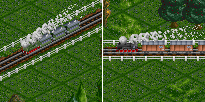 |
This is the very first steam engine in the game, and as such it is only capable of hauling small numbers of coaches at
rather low speed. However, the engine is quite cheap and its good maximum tractive effort makes it better suitable for
hilly terrain than some of the later steamers, but even the earliest electric engine will beat it hands down, as long as
you can afford the higher price and the extra costs for catenary. Originally, this loco was built between 1910 and 1922 for the KPEV (Königliche Preußische Eisenbahnverwaltung - Royal Prussian Railways Administration) and numbered as T-13. It was renumbered into BR 92 after the restructuring of Germany's railway administration. |
BR 75 (wü T5)
introduced 1922, top speed 80 km/h, tractive effort 101 kN
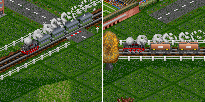 |
This one is a bit stronger and somewhat faster than the BR 92, so it can be used for similar services on branch lines, where
a tender engine takes up too much station space. However, its tractive effort is a bit lower, so the BR 92 will outperform
it in hilly terrain. Originally, the T5 has been built between 1910 and 1920. They were mainly used for local services in the Stuttgart region. The last units were set aside in 1963. |
BR 38 (pr P8)
introduced 1923, top speed 100 km/h, tractive effort 138 kN
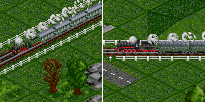 |
This is the first tender engine to be introduced (in about 1922), and it is a little faster and stronger then the
BR 92, but it is not as good at climbing hills. It is best suited to smaller length passenger services over mostly flat
landscape. Though it was developed for passenger trains, it can also transport short freight trains on flat land. The Prussian P8 is a classic, between 1906 and 1928 more than 3800 units were built and used for passenger services all over Germany. The last units were retired as late as 1970. |
BR 18
introduced 1925, top speed 115 km/h, tractive effort 90 kN
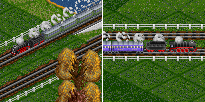 |
This is a fast express engine, well suited for medium and premium passenger trains over a mostly flat landscape. It will
struggle a little going over hills, and will have problems with taller mountains. It is also the first engine to have
access to the Rheingold coaches (1928-1939), and is best used for premium services over long distances. Note that you
cannot use it for freight services. Being considered as the finest four cylinder Pacific steamer of its time, the BR 18 was the best choice for hauling the luxurious Rheingold trains, but also for other heavy passenger services in South Germany. After World War II, they were soon replaced by newly built electric engines. |
BR 01
introduced 1930, top speed 130 km/h, tractive effort 152 kN
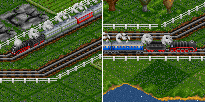 |
The BR 01 is probably the best multi-purpose passenger train steamer in the DB set. It is faster than a BR 18 and better suited to hills
than a BR 05. This loco can be used for any kind of passenger service, but the best tasks are medium and premium services
on the main lines. This loco also has access to the Rheingold coaches, as well as the blue coaches of the "F"-Trains. You
might also use it for express freight trains transporting mail and valuables. The BR 01 was developed under a new standardization programme in the early 1920s. Until 1938, about 230 units have been built and put into use for express services all over Germany. By the end of the 1960s, most units had been taken out of service at the DB, in East Germany they continued to haul heavy express trains between Dresden and Berlin until the late 1970s, the last units to be retired as late as 1981. |
BR 85
introduced 1932, top speed 80 km/h, tractive effort 280 kN
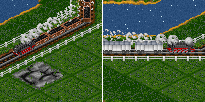 |
This small loco offers lots of tractive effort and is therefore best used for freight services, but it can also be used
for regional services in the mountains. It is best suited for medium freight services which do not warrant the use of
electrics. The only drawback of this loco is its low power, but two locos should be enough for just about every freight
train. Compared to the electrics of its time, this one is a good and cheap alternative. The BR 85 was especially developed for helper services at the ramps in South Germany, where they were used until 1960. |
BR 05
introduced 1935, top speed 165 km/h, tractive effort 154 kN
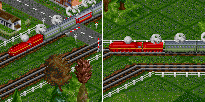 |
This is a pure and simple express passenger locomotive. It has a very high speed, but it is also a very weak locomotive. It
will be very hard to beat on a flat line, but almost unusable as soon as gradients are involved. Of course, this type
cannot be used for freight services. This streamlined type was developed for high-speed services on the Berlin-Hamburg route, and only three units were built. In 1936, one of them broke the barrier of 200 km/h during a test run. After being sidelined during the war time, these engines were rebuilt and lost their streamlined hull. They were then used for premium services in North Germany until being retired in 1958. One of them is now displayed in its original streamlined form in a museum in Nuremberg. |
BR 45
introduced 1936, top speed 90 km/h, tractive effort 260 kN
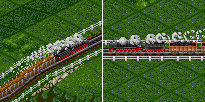 |
The BR 45 is the heavy-freight steamer in the DB Set. It is a slower locomotive, but has a lot of power to compensate. It
hauls any kind of cargo in any terrain, although for mountainous terrain a BR 85 would be even better. This type was the most powerful German steam engine, and it is quite fast for a freight locomotive. Due to World War II, production was cut down to 28 units. After the war, 27 of them were in West Germany and used for heavy freight services until 1968. The 28. unit ended up in East Germany and parts of it were used for the high-speed locomotive 18 201. |
Summary
| Model | Introduction | Usage |
|---|---|---|
| BR 92 | 1920 | basic passenger and freight services |
| BR 75 | 1923 | local services, basic freight services |
| BR 38 | 1923 | regional services |
| BR 18 | 1926 | premium and medium services until about 1950, then regional services on main lines |
| BR 01 | 1930 | premium and medium services until the early 1960s, then regional services on main lines |
| BR 85 | 1932 | freight services, regional services in mountainous areas |
| BR 05 | 1935 | premium services in flat terrain |
| BR 45 | 1936 | any kind of freight service |
Diesel
V-140 (V-16)
introduced 1936, top speed 100 km/h, tractive effort 137 kN
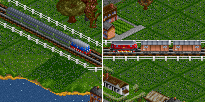 |
Realistically, this is a very weak and unreliable diesel, as it is an early model. It fulfills the same role as the BR 92,
best used for shorter passenger services. Concerning freight services, this loco is best suited to shorter routes or filler
services. This type was the very first diesel engine to be commissioned in Germany. Only one prototype was built and served as testing engine for hydraulic transmission. It was put into service as V-16 in 1937, but because of the outbreak of World War II and the resulting fuel shortage series production was cancelled. The existing loco was renumbered to V-140 and used until 1954 before being transferred to the "Deutsches Museum" in Munich. |
BR 221 (V200)
introduced 1954, top speed 140 km/h, tractive effort 235 kN
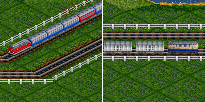 |
The V200 is an unsurpassable passenger locomotive. It is more powerful and faster than a BR 01. Until the end of the 1960s
it can be used for any medium and premium passenger services, towards the mid 1970s the scope can be changed more towards
freight work. The V200 was the first really successful diesel engine in Germany, and is considered an absolute classic. They hauled pretty much every kind of passenger train throughout West Germany. As electrification progressed they were relegated into minor passengers services and freight duties in the 1970s. The last units were retired in the 1980s. |
BR 212 (V100)
introduced 1962, top speed 100 km/h, tractive effort 176 kN
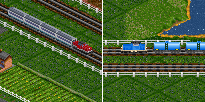 |
This is one of the most versatile locomotives in the DB Set. It may appear to be slow and useless when compared to other
locomotives of its time, but has proven very useful for regional passenger services, when there is no need for a faster and
more expensive locomotive. It is also very useful for filler services (for example, taking containers from a dock into a
city), and regional freight services. About 750 units were built in the 1960s, being used for regional services and light freight trains. Some of them are still running, though most had been retired by the late 1990s. |
BR 218 (V160)
introduced 1968, top speed 140 km/h, tractive effort 235 kN
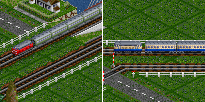 |
The V160 is the successor of the V200. It was designed for heavy passenger services and can haul any medium and premium
trains until the early 1980s. In later years it was mainly delegated into regional services, as well as some lighter
freight services. During the 1960s a whole family of locomotives was developed, all looking similar, but using different engines and transmissions to be used for different services. The BR 218 is the longest living type, quite a lot of them are still in use today. Initially used for premium services, most of them are now running regional services. |
BR 232
introduced 1973, top speed 120 km/h, tractive effort 410 kN
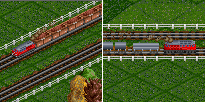 |
The BR 232 is a very heavy freight locomotive. It can be used for pretty much any freight service, but it will excel at
long and heavy transports. With its enormous tractive effort it is best used in hilly and mountainous terrain. These heavy diesel electric engines were built in the Soviet Union and delivered to East Germany between 1973 and 1982. They were used for all kinds of services, even express trains. After 1990 they were almost completely delegated into heavy freight service, especially cross-border services with Holland and Belgium. Planned passenger services have become quite rare, but BR 232 can often be found hauling regional trains as the modern train sets seem to be quite unreliable. |
DE-AC33C "Blue Tiger"
introduced 1997, top speed 160 km/h, tractive effort 517 kN
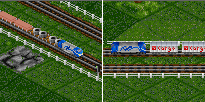 |
This is the only modern diesel in the set, and its high tractive effort makes it ideal as a replacement for the BR 232 for
all kinds of freight services, though with its top speed it is also suited for passenger duties. The "Blue Tiger" diesel electric engine was developed by General Electric and Adtranz (Bombardier) for the Asian market. It was tested for freight services by DB and BASF, but no orders were placed. However, Malaysia and Pakistan have been delivered with this locomotive, as well as some privately owned companies in Germany. |
Summary
| Model | Introduction | Usage |
|---|---|---|
| V-140 | 1936 | basic passenger and freight services, if at all |
| V200 | 1954 | premium and medium services until the mid 1970s, then regional and freight services |
| V100 | 1962 | regional and filler services |
| BR 218 | 1968 | medium services until the late 1980s, then regional services, light freight services |
| BR 232 | 1973 | all kinds of freight services |
| DE-AC33C | 1997 | all kinds of freight services |
Electric
E62 (bav EP1)
introduced 1920, top speed 60 km/h, tractive effort 133 kN
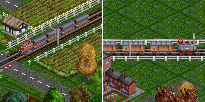 |
This is the first electric engine. It offers a little more tractive effort than a BR 92, so it can be used in terrain
where a BR 92 struggles. However, being a very early design, it is not capable of doing main line services, so it is
restricted to branch lines and the mountains. Originally built as early as 1912, this type is one of the very first electrics in Germany. It was used in the hilly areas of Bavaria and Austria before being set aside in 1955. |
BR 152 (E 52, bav EP5)
introduced 1924, top speed 90 km/h, tractive effort 196 kN
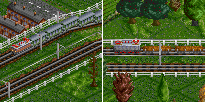 |
This is the first main line electric locomotive in the set, and it comes with a large price tag. This is easily
justified, as this locomotive is best used for regional passenger services in hillier regions, when a steam locomotive can’t
tackle the grades. It is best used alongside the E16, for early electrical networks. Though primarily designed for passenger
services, it can also haul any kind of freight train. The 35 units built were designed for heavy passenger duties on the hilly Bavarian routes. In their early years they were even used for express services, but their main use were regional and freight trains. The last units were retired in 1972. |
BR 116 (E 16, bav ES1)
introduced 1926, top speed 120 km/h, tractive effort 141 kN
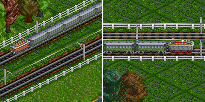 |
The E16 is the first express electrical locomotive in the set, and although it costs a fair bit more then the E52, it is
easily worth it. It is used for express trains up until about 1962, when the BR 110 is introduced to take over. After this,
it can be used for regional trains up until the late 1970s. Like the E52, this engine was developed for the hilly lines in Bavaria. With its higher top speed it was destined for express passenger services. In the mid-1960s the newly developed E10 (BR 110) forced them into regional services before being set aside. The last units were retired as late as 1979. |
BR 175 (E 75)
introduced 1928, top speed 70 km/h, tractive effort 235 kN
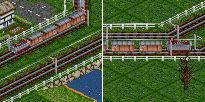 |
This engine is the first electric in the set to be designed for freight trains, but it can also be used for regional
services, although a E52 is better suited for that task. Being one of the early freight electrics, this engine was just a glimpse of what was to come later. This type was used in Bavaria as well as the electric network of central Germany, in the area of Halle-Leipzig. After World War II these engines served in West Germany until 1972. |
BR 195 (E 95)
introduced 1928, top speed 70 km/h, tractive effort 353 kN
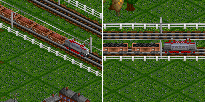 |
This is the first really heavy electric freight locomotive in the set, it has a higher tractive effort and more power than
the E75. This loco is a prime candidate for any kind of long and slow freight service, especially in the mountains. Originally these engines were designed for heavy coal trains in the Silesia region. After the end of World War II they had to be handed over to the Soviet Union. In 1952 three of them were given back to East Germany, but their poor condition prevented any usage until being overhauled in 1959. They then served another ten years before finally being retired in 1970. |
BR 144 (E 44)
introduced 1935, top speed 90 km/h, tractive effort 200 kN
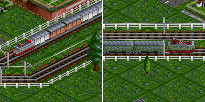 |
This locomotive has similar characteristics as the E52, but it is much cheaper and more reliable. It can be used for
regional services, but also for any kind of freight services for more than 50 years. Originally, 175 units were produced. Though primarily designed for freight services, they also hauled regional trains if necessary. The locos of this type proved very reliable, so they were in use until the early 1980s. |
BR 194 (E 94)
introduced 1940, top speed 90 km/h, tractive effort 363 kN
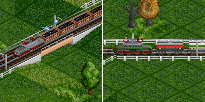 |
This locomotive is also known as the "German Crocodile", and is one of the most powerful freight locomotives in the DB Set. It is
especially designed for working in mountainous terrain. It forms the backbone of bulk material transports until the BR 150
and BR 250 enter service. The E94 is one of the most famous German locos, developed especially for the steep grades and ramps in South Germany. It was produced throughout World War II and has been used for heavy freight services in the South and the Halle-Leipzig area. The last units went off service in the late 1980s. |
BR 140
introduced 1956, top speed 110 km/h, tractive effort 320 kN
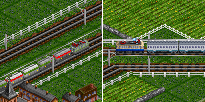 |
This is the first modern electric locomotive to be used in Germany, and an early attempt at designing a universal engine.
It is best suited to regional trains both in and out of the mountains and works fairly well with freight trains as well. This loco was part of the electrification programme after World War II. Designed for regional passenger services as well as freight trains, this loco was used for all types of trains except express services. In total, more than 850 units have been built and some are still in use today, though their number is constantly decreasing. |
BR 110 (E 10)
introduced 1956, top speed 150 km/h, tractive effort 275 kN
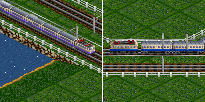 |
This is the next generation of express passenger locomotive, designed to replace the pre-war electrics and steamers. It is
best used for all kinds of premium and medium trains until the mid 1970s, when the premium trains are taken over by the
BR 103. It is still usable for any kind of medium service throughout the 80s, but is degraded into regional services by
1990. This is also a type not be used for freight services. Developed in the same programme as BR 140 and BR 150, this loco was the backbone of fast passenger service on the electric lines for a very long time. Even today quite some units are still running regional services, though slowly being replaced by newly developed types. |
BR 150
introduced 1957, top speed 100 km/h, tractive effort 443 kN
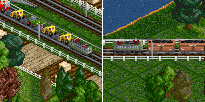 |
This one is the successor to the E94, designed for hauling the heaviest freight trains through difficult terrain. It can
easily haul just about any kind of freight, the heavier and slower, the better. Like the BR 140 and BR 110 this type was developed in the 1950s to replace the pre-war engines. As such it is a powerful 6-axle engine with an enormous tractive effort. These engines saw heaviest freight duties all over Germany, sometimes even multi headed, until they were retired in early 2003, their services being taken over by more modern types. |
BR 103
introduction 1969, top speed 200 km/h, tractive effort 312 kN
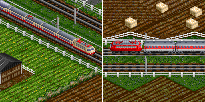 |
The BR 103 is a revolution amongst the electrical locomotives in the DB Set. It easily outpaces all of the other trains in
the set with regards to passenger hauling – regardless of the terrain involved. It is of course best suited for any premium
train services, be it TEE or Intercity. Realistically, this engine does not allow attaching of freight wagons. Developed for high speed services in the early 1960s, this engine was tested for 250 km/h, but in regular services 200 km/h was still fast enough. All units saw heavy service on national and international trains, many of them running more than 30.000 km per month. Retirement of this type started in the late 1990s, when the BR 101 became available. The last units were set aside in 2003. |
BR 155 (ex BR 250)
introduced 1974, top speed 125 km/h, tractive effort 380 kN
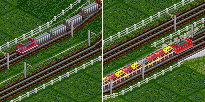 |
This heavy freight loco is even more powerful than the BR 150, but has a bit less tractive effort. However, due to its
higher speed it can also be used on mainlines among passenger traffic. Originally developed as heavy freight engine for the East German railways, this type was used for any kind of service, even heavy express passenger trains. After reunification in 1990 it was renumbered to BR 155 and has been used for all kinds of heavy freight services ever since, eventually replacing the older BR 150 type. |
BR 181
introduced 1974, top speed 160 km/h, tractive effort 271 kN
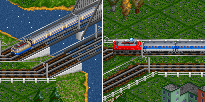 |
This loco is ideally used for any medium services, replacing the older BR 110. On the other hand, this engine is quite
unreliable, so it should be kept out of premium services. Due to its low power it is not well suited for freight transport. This type was developed for the different electric systems of France and Germany, so it has mainly been used in cross border services between both countries, hauling passenger trains as well as light freight trains. |
BR 111
introduced 1975, top speed 150 km/h, tractive effort 274 kN
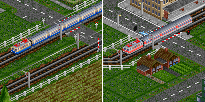 |
This one is a modernized version of the BR 110 and upon introduction it is best used for similar services, i.e. medium and
premium passenger services. In 1980 its role changes towards local services with the introduction of S-Bahn trains, a
special type of commuter services in big cities. Like the BR 110 and BR 103, this type cannot be used for freight services. Originally developed as modern successor to the BR 110, this type was used for all kinds of fast passenger services. In 1980 they were introduced to commuter services in the Rhein-Ruhr-area, though not really well suited for this kind of service. Today they can only be found in regional services. |
BR 120
introduced 1979, top speed 200 km/h, tractive effort 340 kN
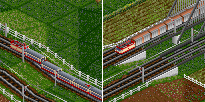 |
Designed originally as a replacement for the BR 103, this locomotive excels at hauling fast passenger trains in medium and
premium services. Besides, it can also be used for fast freight services, like transporting boxed goods. However, due to
its nature as "universal" locomotive it is comparably unreliable. This engine was a milestone in the development of electric engines in Germany, it was the first to use three-phase asynchronous motors. However, numerous technical problems occured and in the end only 60 units were put into service, mainly for fast passenger and express freight services. |
BR 112
introduced 1990, top speed 160 km/h, tractive effort 248 kN
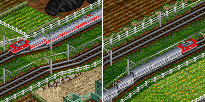 |
This locomotive is a modern passenger locomotive, built as a successor to the BR 111 and BR 110 locomotives. It is best
used for medium and premium passenger services. After 1997 it can also be used for regional services. The original prototype of this East German engine had already been presented in 1982, when there was no need for a fast engine on the East German network. This suddenly changed with the reunification in 1990, so series production began. |
BR 101
introduced 1996, top speed 220 km/h, tractive effort 300 kN
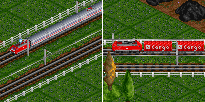 |
This is a very modern electrical locomotive, specifically designed for fast passenger services, to take over from the older
BR 120 and BR 103. It is of course best suited for premium passenger services, but also for fast freight services like
transports of boxed goods. After a series of technical problems with the BR 120, a whole new concept was planned, including a whole family of modern locomotives for all kinds of services, the BR 101 being the one for fast passenger services, replacing the older types like the BR 103. |
BR 182
introduced 2001, top speed 230 km/h, tractive effort 300 kN
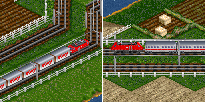 |
The most modern conventional locomotive in the DBSetXL, this type is well suited for any kind of fast passenger service,
but also for hauling heavy freight trains. In short, it's just a bit more powerful and a bit faster than a BR 101. This type is based on the "eurosprinter" engine which can be found in several European countries. In Germany, they are only used for freight services, Austrian units also run cross-border passenger services between Germany and Austria. |
Summary
| Model | Introduction | Usage |
|---|---|---|
| E62 | 1920 | basic passenger and freight services in the mountains |
| E52 | 1924 | regional and freight services |
| E16 | 1926 | medium passenger services until the 1960s, then regional services |
| E75 | 1928 | medium freight services |
| E95 | 1928 | heavy freight services |
| E44 | 1935 | all kinds of freight services, also regional services |
| E94 | 1940 | heavy freight services |
| BR 140 | 1956 | regional services, lighter freight trains |
| BR 110 | 1956 | any medium and premium passenger service, after 1990 regional services |
| BR 150 | 1957 | heavy freight services |
| BR 103 | 1969 | premium passenger services |
| BR 250 | 1974 | all kinds of freight services |
| BR 181 | 1974 | medium and regional passenger services, light freight trains |
| BR 111 | 1975 | medium services until 1980, then S-Bahn services |
| BR 120 | 1979 | premium passenger services, fast cargo trains |
| BR 112 | 1990 | premium and medium passenger services, after 1997 also regional services |
| BR 101 | 1996 | premium passenger services, fast freight trains |
| BR 182 | 2001 | mainly fast freight trains, but also premium passenger services |
Train Sets
VT-137
introduced 1933, top speed 150 km/h
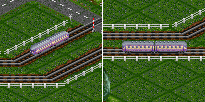 |
Designed as high speed diesel train sets, these units will work best over flat terrain, as it will give them a chance
to reach their top speed. Historically, they were used in pairs (i.e. a set of two "heads" and no coaches), but for
convenience, long-distance coaches can be added. Several types of fast diesel train sets were developed in the 1930s. They were used for express services between major cities, for example on the Berlin-Hamburg route, or connecting Berlin-Halle-Nuremberg-Munich, setting travel times that could only be broken very recently. With the outbreak of World War II all diesel train sets were sidelined. |
VT-08
introduced 1952, top speed 120 km/h
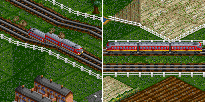 |
Initially this type was designed for high-capacity express services, but after the introduction of the VT-11 it is mainly
used for medium and regional services. The main benefit of its design is that the train sets can be any length needed
(although sometimes it may be better to use two smaller sets coupled together). Originally designed to replace the pre-war train sets, these units saw premium passenger duties in the 1950s, but due to electrification they lost this role and were rebuilt for regional services. |
VT-95
introduced 1952, top speed 90 km/h
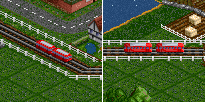 |
This rail bus, whilst not a train set of the normal type, differs enough from conventional trains to be included here. This
train really excels at short passenger services on branch lines, as it is cheap and has a good capacity. Historically, it
has been used in pairs with one motor car and one trailer vehicle (a local coach), but you could just as easily use two or
even more motorized cars for better acceleration. However, if you need more than two cars, you should consider using another type
altogether. This type was developed as a low-cost replacement for the last steamers on branch lines and light railways. It served for more than fourty years. |
VT-11
introduced 1957, top speed 140 km/h
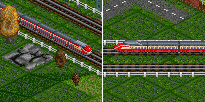 |
The VT-11 was a fast diesel train set, working well on mainlines. A VT-11 set would consist of a pair of motor units, and
between 5 and 8 long-distance coaches in between these two heads. However, after 1974, the loco has limited uses as there
are many better trains to use for premium services. This type was designed for the first-class only TEE (Trans-Europe-Express) services, high-quality express trains connecting major cities, travelling on routes like Hamburg - Zurich or Dortmund-Paris. These units were later replaced by electric locos and set aside in the late 1970s. |
BR 614
introduced 1972, top speed 140 km/h
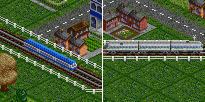 |
This is a trainset for local and regional services. Note that this set "assembles" itself, i.e. you buy the head and just
have to add the correct number of local coaches. A typical consist is made up of three units, the middle one being
unpowered. Adding another three coaches yields two consists coupled together. Put into service in the early 1970s, this type has since been used for regional services on branch lines in Bavaria as well as the Northwest of Germany. |
BR 605 (ICE-TD)
introduced 1998, top speed 200 km/h
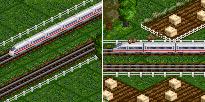 |
This is a train set similar to the ICE-3, except that it is powered by diesel engines, so it can be used for premium
passenger services on non-electrified lines. For convenience, there is no restriction concerning the number of long-distance
coaches to be used with this type, but realistically it should be fielded in sets of 4 (two heads, two coaches). This type uses modern tilting technology and was developed with the Dresden-Nuremberg line in mind, which was never fully electrified. A normal consist is made of two units and two coaches, and several consists can be coupled together. However, this type was retired in 2003 after a series of technical failures. |
BR 612 "Regioswinger"
introduced 1998, top speed 160 km/h
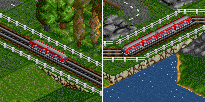 |
The "Regioswinger" (so named because of tilting technology) is a fast diesel commuter train, best used for regional trains.
However, it loads as fast as the S-Bahn coaches, so it is also very useful to replace the older types in this kind of
service. Although you can attach additional coaches, it is better to attach additional consists of two heads each. This set consists of two powered units, but if required two or even three consists can be coupled to get enough capacity. |
ET-87
introduced 1927, top speed 100 km/h
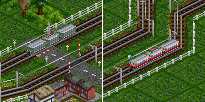 |
This train set can be used for regional services on early electric networks, alongside the E52 and E16. This set
"assembles" itself, you buy the head and simply attach cars until the consist of three cars is complete. Adding another
three doubles the consist. The six units of this type originally served on the Silesian network well before 1920. After World War II, half of them ended up in the Soviet Union, the other three were used for commuter services around Nuremberg until 1959. Note that these sets can only run 70 km/h, the TTDX type is faster, to make up for its later introduction date. |
ET-11 (el T 1900)
introduced 1935, top speed 160 km/h
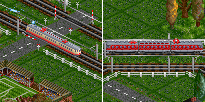 |
These high speed electric train sets are designed for premium services, and are best used alongside the E16. However, the
ET-11 does not have as much power as the E16, and is better suited to flatter terrain. This is also one of the
"self-assembling" sets, to be used with one or two long-distance coaches. Originally, this type was developed for the Berlin-Munich route, but electrification of this line was not completed until mid-war, when express services were not needed. Instead, these units served on the Stuttgart-Munich line until 1964. |
BR 515
introduced 1954, top speed 100 km/h
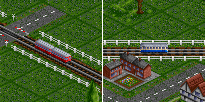 |
This set is quite special since it is battery-powered. As such, its low power and tractive effort limit it to local and
regional services on branch lines in flat areas. Still, it is a good alternative to using busses. These units were built to replace older engines, especially steamers, on the branchlines and local services. The range of the batteries was about 500 km, so these units saw service all across the flatter areas of Germany. The last units were set aside in 1995. |
ET-30
introduced 1956, top speed 120 km/h
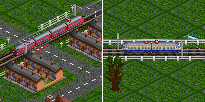 |
Most commonly used in sets of 3, these trains were originally intended for local and shorter regional services in the
1950s, but of course they can continue in these services for much longer. Being similar in their shape to the existing VT-08, these units served the metropolitan commuter and regional services in the Ruhr area. In 1984, the last one was set aside, being replaced by newer S-Bahn services. |
BR 420
introduced 1971, top speed 140 km/h
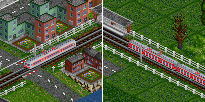 |
This is the first set specifically designed for S-Bahn services and is best used alongside the BR 111 for these services.
After 1997 they can also do regional services. The BR 420 is "self-assembling", one unit consisting of two motor units and
a coach in the middle, but several units can be linked if higher capacity is needed. These units were put into service for the new S-Bahn type that was started in several big German cities in the mid 1970s. This type was a big success and is still running today. Note that the top speed was increased for better gameplay. |
BR 401 (ICE-1)
introduced 1990, top speed 280 km/h
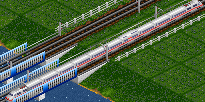 |
The ICE-1 is the first of the high-speed ICE trains, only used for the fastest kind of premium services available. This type
uses two motor units and usually 12 long-distance coaches, though more or less can be used as applicable. A dining car is
added automatically if the train is long enough. Note that due to its high top speed, these trains should be used on
dedicated high-speed lines. Being designed for the newly built high-speed line Hannover-Wurzburg, this train was the fastest type of transport available on rails, until the ICE-3 was put into service. Sixty units were delivered, and all are still in service, except for the one that has been destroyed in the heavy crash at Eschede in 1998. |
BR 403 (ICE-3)
introduced 1999, top speed 330 km/h
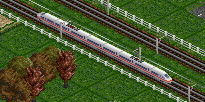 |
This type is the newest high-speed type of train to be available in the set and can be used alongside the older ICE-1 units.
One complete unit consists of eight cars, which can also be doubled for maximum capacity. This is done via the
"self-assembling" scheme by adding long-distance coaches. Being even faster than the ICE-1, this type is the fastest unit to be operated on conventional rails in Germany. This type was specifically developed for the new high-speed line from Cologne to the Rhein area which uses steeper grades than previous high speed lines. |
Summary
| Model | Introduction | Usage |
|---|---|---|
| VT-137 | 1933 | premium services in flat areas |
| VT-08 | 1952 | local and regional services |
| VT-95 | 1952 | regional services on branch lines |
| VT-11 | 1957 | premium services (TEE) |
| BR 614 | 1972 | local and regional services |
| BR 605 (ICE-TD) | 1998 | premium services |
| BR 612 | 1998 | any local and regional service, also suited for S-Bahn services |
| ET-87 | 1927 | regional services |
| ET-11 | 1935 | premium services |
| BR 515 | 1954 | local and regional services |
| ET-30 | 1956 | local services |
| BR 420 | 1971 | S-Bahn services |
| BR 401 (ICE-1) | 1990 | high-speed premium services |
| BR 403 (ICE-3) | 1998 | high-speed premium services |
Coaches
There are quite a variety of coaches and carriages for the different freights, but in the end it all comes down to a very limited set of types. Many of these coaches come in different liveries, so the look is quite varied, but they have similar specifications. Note that the given maximum speed only applies with "wagonspeedlimits on" in your ttdpatch.cfg! Note that certain engines and train sets override the basic specs with custom ones - these types will be dealt with further down. Additionally, train sets have custom specs as well, these can be found in the manual of the set.
Passenger and mail coaches
pre-war coaches
30 passengers / 18 bags of mail, maximum speed 100 km/h
These are the very first coaches to be available. They are shorter than the regular ones, load slower and have a lower capacity. Two liveries are available, depending on the hauling engine (brown with the early Bavarian electrics, dark green for the steamers). These coaches should be replaced when newer local coaches become available.
local coaches
40 passengers / 24 bags of mail, maximum speed 140 km/h
These are the coaches used for all kinds of local and regional services. They are introduced in 1925 and come in a variety of forms and liveries, the newer ones replacing the older versions. However, apart from looking different, there are only three main types to be distinguished, as shown in the table below.
| Year | Load* | Remarks |
|---|---|---|
| 1925 | 8 / 6 | until 1930 Type "Thunderbolt" |
| 1960 | 10 / 12 | DB Coach "Silverfish" |
| 1987 | 20 / 12 | until 1987 in white/mint, then in traffic-red livery |
long-distance coaches
56 passengers / 36 bags of mail, maximum speed 160 km/h, after 1987 unlimited maximum speed
These coaches are first available in 1925 and have a slightly higher capacity than the local coaches. They are also built for higher speed. Again, over the years they come in many different liveries, as shown in the table.
| Year | Load* | Remarks |
|---|---|---|
| 1925 | 7 / 9 | Type "Hecht" ("pike" coaches) until 1935, then semi-streamlined |
| 1950 | 8 / 9 | in green until 1974, then cream/blue |
| 1987 | 14 / 12 | white/red Intercity livery until 1997, then in ICE colors |
Additionally, there are Interregio coaches in white/blue livery from 1987 to 1997, with a capacity somewhere in between the local and long-distance coaches of that time.
S-Bahn coaches
These special passenger coaches differ from the regular ones because of their loading speed - they can be loaded / unloaded in one tick. Regular coaches take three to four ticks to fully load. Naturally, these coaches can be best used for commuter services with lots of passengers on short routes with many stops. These coaches are used for the BR 614 train set and the BR 111 in S-Bahn livery, as well as the BR 612 "Regioswinger" train set.
other coaches
Several train sets and engines override the regular coaches with fitting custom ones - you wouldn't want to see a regular long-distance coach on an ICE, would you? Sometimes this override not only changes the appearance, but also the passenger capacity and / or loading speed. Since these changes are too numerous to be listed here, I advise everyone to read through the list given in the manual of the set.
Freight wagons
DBSetXL comes with a variety of new freight wagons. As most of them can be refitted to carry different cargo, there are actually very few different types of wagons to be listed for the different types of freight service as listed above.
open wagons / self-discharging hoppers
These wagons are used for bulk materials like coal, iron ore and grain, but open wagons are also refittable for goods, though there are better wagons with a higher capacity and a higher maximum speed available. As these cars are open, their maximum speed is limited to avoid breaking couplings and cargo getting lost due to air resistance. The self-discharging hoppers are also fairly heavy, so only the most powerful engines should be used to haul them.
flat wagons
No matter whether you need to transport steel, lumber, paper, machinery parts, containers or other things, usually you need some kind of flat wagon. These versatile wagons can be used for pretty much everything except bulk materials. Since the cargo is fastened to the wagon, the maximum speed can be higher than for the open wagons. Also, these wagons are comparably lightweight, which might be an important factor in the mountains.
closed wagons
There are two main types of closed wagons, the first being the ones for livestock, the latter being the sliding wall and tarpaulin wagons for goods. As the cargo is different, so is the maximum speed of the wagons, the goods wagons transporting boxed goods allowing quite high speeds. On the other hand, livestock can only be transported at lower speeds, so an older engine will suffice.
tankers
Tankers are of course used for liquid cargo, which in TTDX is oil and chemical goods. These are somewhat similar to bulk material and fairly heavy wagons, so a powerful engine is recommended.
overview table
| Year | Type | Capacity | Speed | best used for |
|---|---|---|---|---|
| 1920 | short low side | 15 t | 60 km/h | anything |
| 1920 | short tanker | 15 t | 60 km/h | crude oil |
| 1920 | short closed wagon | 15 t | 60 km/h | livestock, goods |
| 1930 | low side wagon | 25 t | 80 km/h | coal, iron ore, grain |
| 1930 | flat wagon | 25 t | 80 km/h | lumber, steel, paper, goods |
| 1930 | closed wagon | 30 t | 80 km/h | goods, livestock |
| 1935 | high side wagon | 28 t | 80 km/h | coal, iron ore, grain |
| 1940 | tanker | 30 t | 80 km/h | crude oil |
| 1950 | self-discharging hopper | 40 t | 80 km/h | coal, iron ore, grain |
| 1950 | closed wagon* | 30 t | 100 km/h | livestock, goods |
| 1950 | flatbed wagon | 30 t | 100 km/h | goods |
| 1950 | refrigerator | 30 t | 120 km/h | goods |
| 1970 | high side wagon* | 30 t | 120 km/h | coal, iron ore, grain |
| 1970 | flat wagon* | 30 t | 120 km/h | lumber, steel, paper, goods |
| 1970 | refrigerator* | 30 t | 140 km/h | goods |
| 1975 | container wagon | 40 t | 120 km/h | goods |
| 1975 | sliding wall wagon | 35 t | 140 km/h | goods |
| 1980 | car transporter | 35 t | 140 km/h | goods |
| 1980 | tanker* | 40 t | 120 km/h | crude oil |
| 1990 | flatbed wagon* | 40 t | 140 km/h | goods |
| 1990 | self-discharging hopper* | 40 t | 120 km/h | coal, iron ore, grain |
| 1990 | tarpaulin wagon | 40 t | 160 km/h | goods |
Additional information
weight tables
This table shows the weights of a train that an engine manages to pull up a mountain of a given height, i.e. the total
weight of the train minus the weight of the loco itself. This was tested with "freighttrains 5" and the short low-sided
wagon. Also, a checkpoint station was placed right before the climb, so that the train had to start from a dead stop.
Approaching a climb at full speed would yield quite different results, but they would not be useful as soon as the train
had to stop during a climb because of a signal, for example. Passenger engines have only been tested concerning their
load in flat land, testing climbs was useless as the number of the light passenger coaches to be used would have exceeded
any sensible means, i.e. the trains would have been longer than 20 squares, which would never occur in normal games.
The column for flat terrain just shows the weight with which the engine was still able to reach its maximum speed. This was
tested without speed limits for wagons, of course. With "wagonspeedlimits on", this value becomes quite meaningless.
Note that these weights are rounded, so you might still be able to go above these limits. Empty cells mean that there was
no real limit to be found, so any train weights should be possible.
As you can see, steamers are comparably weak (we already knew that, didn't we?). The other interesting result is that most engines can pull quite heavy loads in flat terrain AND up small climbs. So if your lines are built so that a train does not have to climb two or more slopes at once, it can still be quite long and heavy. Of course, building realistic networks means that you should not have any steeper slopes at all.
Steam
| type | speed | flat | 1 | 2 | 3 | 4 | 5 | 6 | 7 | 8 | 9 | 10 | 11 | 12 | 13 | 14 | 15 |
|---|---|---|---|---|---|---|---|---|---|---|---|---|---|---|---|---|---|
| BR 92 | 50 km/h | 750 t | 150 t | 100 t | |||||||||||||
| BR 75 | 80 km/h | 600 t | 150 t | 100 t | |||||||||||||
| BR 38 | 100 km/h | 400 t | 150 t | ||||||||||||||
| BR 18 | 115 km/h | 650 t | not tested | ||||||||||||||
| BR 01 | 130 km/h | 650 t | 300 t | 150 t | |||||||||||||
| BR 85 | 80 km/h | 1100 t | 400 t | 350 t | |||||||||||||
| BR 45 | 90 km/h | 2000 t | 500 t | 350 t | |||||||||||||
| BR 05 | 165 km/h | 350 t | not tested | ||||||||||||||
Diesel
| type | speed | flat | 2 | 3 | 4 | 5 | 6 | 7 | 8 | 9 | 10 | 11 | 12 | 13 | 14 | 15 |
|---|---|---|---|---|---|---|---|---|---|---|---|---|---|---|---|---|
| V-140 | 100 km/h | 1250 t | 150 t | |||||||||||||
| V-200 | 140 km/h | 750 t | 400 t | 350 t | ||||||||||||
| V-100 | 100 km/h | 650 t | 250 t | |||||||||||||
| BR 218 | 140 km/h | 650 t | 400 t | 350 t | ||||||||||||
| BR 232 | 120 km/h | 1700 t | 1700 t | 1100 t | 650 t | |||||||||||
| DE-AC33C | 160 km/h | 600 t | 850 t | |||||||||||||
Electric
| type | speed | flat | 1 | 2 | 3 | 4 | 5 | 6 | 7 | 8 | 9 | 10 | 11 | 12 | 13 | 14 | 15 | |
|---|---|---|---|---|---|---|---|---|---|---|---|---|---|---|---|---|---|---|
| E62 | 60 km/h | 1250 t | 600 t | 150 t | ||||||||||||||
| E52 | 90 km/h | 2200 t | 500 t | 250 t | 150 t | |||||||||||||
| E16 | 120 km/h | 1250 t | 250 t | 150 t | 100 t | |||||||||||||
| E75 | 70 km/h | 2450 t | 1500 t | 350 t | ||||||||||||||
| E95 | 70 km/h | 6900 t | 2850 t | 600 t | 500 t | |||||||||||||
| E44 | 90 km/h | 1850 t | 1000 t | 350 t | ||||||||||||||
| E94 | 90 km/h | 3350 t | 750 t | 600 t | ||||||||||||||
| BR 140 | 110 km/h | 2750 t | 1000 t | 600 t | 500 t | 400 t | ||||||||||||
| BR 110 | 150 km/h | 1550 t | not tested | |||||||||||||||
| BR 150 | 100 km/h | 3800 t | 3000 t | 900 t | 750 t | 650 t | ||||||||||||
| BR 103 | 200 km/h | 1350 t | not tested | |||||||||||||||
| BR 250 | 125 km/h | 3300 t | 1500 t | 850 t | 650 t | 588 t | ||||||||||||
| BR 181 | 160 km/h | 1000 t | 850 t | 500 t | 400 t | |||||||||||||
| BR 111 | 150 km/h | 1450 t | not tested | |||||||||||||||
| BR 120 | 200 km/h | 1250 t | 850 t | 500 t | 400 t | 350 t | ||||||||||||
| BR 112 | 160 km/h | 1350 t | 850 t | 500 t | 400 t | 350 t | ||||||||||||
| BR 101 | 220 km/h | 1200 t | 900 t | 750 t | 650 t | 600 t | 500 t | |||||||||||
| BR 182 | 230 km/h | 1200 t | 900 t | 750 t | 650 t | 600 t | 500 t | |||||||||||
last updated 26.11.2006
Uwe Domaratius (Uwe.Domaratius@s2000.tu-chemnitz.de)